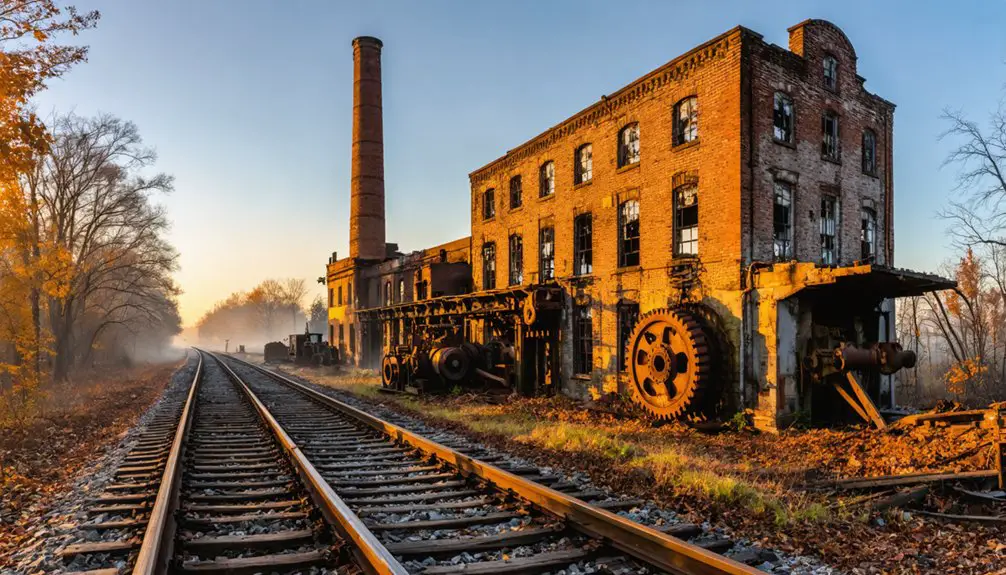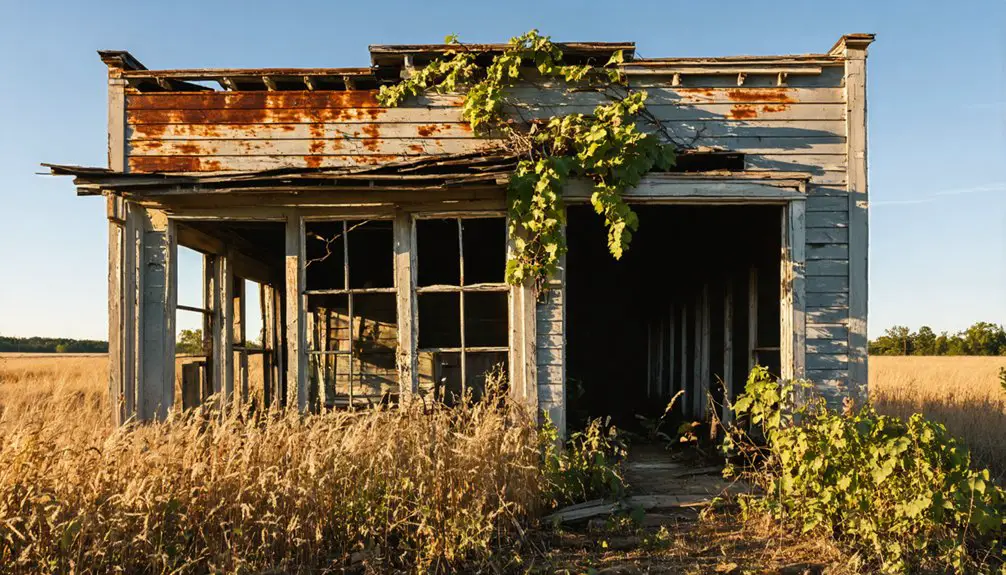You’ll find Potts as a ghost town in northern Michigan, once home to the world’s largest sawmill under J.E. Potts Salt & Lumber Company. In the 1880s, it grew into a bustling community of 700 residents with hotels, stores, and churches, processing 98 million board feet of lumber annually. Diphtheria outbreaks in the 1890s and devastating fires, combined with depleted forest resources, led to its rapid decline and abandonment. The site’s railroad grades and mill ruins tell a deeper story of Michigan’s industrial past.
Key Takeaways
- Potts was a thriving lumber town with 700 residents in 1886, centered around J.E. Potts Salt & Lumber Company’s massive sawmill operations.
- The town featured hotels, stores, churches, and a 50-mile railroad network during its peak as Oscoda County’s largest settlement.
- Severe diphtheria outbreaks in 1893 and 1897 devastated the population, while fires destroyed critical infrastructure.
- Depletion of surrounding forest resources led to economic collapse and the town’s eventual abandonment.
- Historical remnants include railroad grades and mill sites north of the AuSable River, contributing to regional heritage tourism.
Origins of a Lumber Empire
Before the establishment of J.E. Potts’ lumber empire, the land that would become Potts, Michigan was part of the Michigan Territory, inhabited by Native Americans until the 1819 Treaty of Saginaw.
When Potts arrived from Simcoe, Ontario, he recognized the untapped potential of the region’s vast pine forests and the Au Sable River‘s strategic importance for logging techniques and timber sustainability. His purchase of the Backus Brothers mill for $30,000 in 1875 marked the beginning of his ambitious plans for the region.
You’ll find that Potts’ vision transformed the wilderness into a thriving operation by the 1880s. The town grew into a bustling lumber headquarters with hotels, stores, and churches to support the community. He acquired extensive timberlands and established a pioneering salt and lumber enterprise in what was then Comins Township, Alcona County, before it became part of Oscoda County’s Mentor Township.
His strategic land acquisitions near the Au Sable River positioned him perfectly to build one of Michigan’s most significant lumber operations.
The Rise of J.E. Potts Salt & Lumber Company
You’ll find J.E. Potts Salt & Lumber Company’s meteoric rise marked by its construction of the world’s largest sawmill and development of an extensive 50-mile railroad network throughout Michigan’s northern forests.
The company’s innovative approach combined lumber processing with salt production operations, while establishing modern repair facilities and engine shops at their headquarters in Potts. With 700 residents by 1886, the town flourished as the largest settlement in Oscoda County. By 1888, the company was banking half million feet of logs daily.
Strategic Regional Expansion
During the mid-1880s, J.E. Potts launched an aggressive expansion strategy by constructing a narrow gauge railroad that revolutionized timber accessibility in northern Michigan. The strategic 50-mile railway network connected Oscoda, Au Sable, and the logging camp at Potts, transforming previously unreachable pine forests into viable timber resources.
You’ll find that Potts’ expansion wasn’t limited to railroad infrastructure. The company secured 8,000,000 feet of stumpage rights and thousands of acres across Oscoda County, backed by $600,000 in contract liens. The partnership with J. Tindale in 1880s strengthened the company’s position in the regional lumber market.
This massive land acquisition supported a vertically integrated operation featuring the world’s largest sawmill in Oscoda. The company’s strategic network included log floating operations, barges for shipping to Chicago and Canada, and even passenger and mail services, cementing Potts’ dominance in Michigan’s lumber industry.
Innovative Processing Methods
While many lumber companies focused solely on raw timber production, J.E. Potts Salt & Lumber Company pioneered innovative processing methods that set new industry standards.
You’ll find their integrated facilities combined lumber and salt production with sustainable practices that maximized resource efficiency. Drawing from established wood treatment history, they utilized creosote preservation methods to significantly extend the lifespan of their lumber products. They’ve implemented advanced preservation techniques including full-cell wood treatment and mechanical incising to enhance wood durability.
The company’s facilities featured steam-powered circular saws, gang mills, and modern electric lighting.
Their innovative water storage system could handle 1.5 million feet of logs, ensuring continuous production flow. You’ll appreciate how they’ve incorporated cutting-edge shingle machines and improved frame circular saws to boost output quality.
Their careful management of water channels and processing waste demonstrated an early commitment to environmental stewardship that was ahead of its time.
Local Employment Impact
As one of Michigan’s largest lumber operations in the 1880s, J.E. Potts Salt & Lumber Company transformed the region’s labor dynamics by employing hundreds across diverse roles.
You’d find workers manning the sawmills, felling timber, operating the railway, and managing salt production facilities.
The company’s presence created extensive employment opportunities throughout Potts and neighboring communities like Au Sable and Oscoda. You could witness the economic significance in the bustling company town of 600-700 residents, where the mill’s annual output reached an impressive 75 million board feet of lumber.
The 1886 addition of the Potts Logging Railway further expanded job prospects, requiring railroad laborers while enabling year-round logging operations deeper in the forests.
This integration of rail and river transportation sustained steady employment until the company’s eventual collapse in 1890.
Daily Life in a Booming Mill Town
Life in Potts centered around the rhythms of its bustling lumber operations, where 700 residents formed a close-knit community of mill workers, railroad employees, and their families.
Your daily routines would’ve revolved around the mill’s production schedule, with most workers living in modest wood-frame houses near their workplace. Like the German rural workers that came before them, most laborers owned no property of their own. You’d find essential amenities like schools, churches, and general stores supporting your daily needs.
Community gatherings were a crucial part of life, with churches and public spaces serving as social hubs where you’d connect with neighbors.
The post office, established in 1886, kept you connected to the outside world. If you’d been a worker, you’d have noticed the seasonal nature of employment, with logging activity peaking during spring and summer months.
Economic Peak and Industrial Achievement

During its peak in the mid-1880s, you’d find Potts had become Oscoda County’s largest settlement with 700 residents supported by one of Michigan’s most extensive lumber operations.
You’d see the J.E. Potts Salt and Lumber Company’s impressive industrial infrastructure, including a major sawmill, railroad networks, and equipment that processed vast amounts of timber. Similar to other logging towns like Jennings that produced 100 million board feet annually, the mill operated at maximum capacity to meet industry demands. Like the town of Pere Cheney, Potts relied heavily on railroad stops to transport lumber and supplies.
If you’d visited before its 1890 collapse, you’d have witnessed the height of the town’s prosperity, with hundreds employed in lumber production and the mill running at full capacity to meet Michigan’s booming timber demands.
Lumber Production Records
When J.E. Potts’ mill at AuSable achieved an unprecedented lumber production of 98,000,000 board feet in 1890, it wasn’t just setting a world record – it was demonstrating the pinnacle of industrial efficiency in Michigan’s golden age of lumber.
You’ll find the achievement even more remarkable considering how they made it possible: the mill ran continuously, using electric lights for 24/7 operations during peak periods. This round-the-clock production focused primarily on white pine, the most sought-after wood of the era.
Michigan led the nation’s lumber output from 1869 to 1900, and Potts’ operation exemplified this dominance. However, the very year they set their production record also marked their downfall, as the company’s financial overextension led to its collapse under mounting creditor pressures.
Community Economic Prosperity
The small settlement of McKinley, serving as Potts’ headquarters, emerged as Oscoda County’s largest community in the 1880s with a thriving population of 700 residents by 1886.
You’d find a bustling town with shops, machine shops, and churches, showcasing strong community engagement through civic structures and social gatherings.
The town’s economic prosperity extended beyond lumber production. You could witness the J.E. Potts Salt and Lumber Company’s diverse operations, including salt processing and equipment maintenance facilities. Similar to the iron-smelting town of Fayette, Potts represented Michigan’s industrial boom during the late 1800s.
The establishment of a post office in 1886 strengthened social cohesion, while the railroad network connected you to Lake Huron markets.
Workers and their families benefited from the round-the-clock mill operations under electric lighting, representing the peak of industrial achievement before the company’s eventual bankruptcy in 1890.
Industrial Infrastructure Growth
Industrial expansion at Potts reached remarkable heights through strategic infrastructure development in the 1880s. When you explore the town’s industrial legacy, you’ll find that J.E. Potts Salt & Lumber Company established impressive lumber milling operations that transformed this frontier settlement into Oscoda County’s largest community of 700 residents.
- Lima-built locomotives transported timber on an extensive rail network connecting to Lake Michigan
- Advanced sawmill machinery enabled mass timber production and processing
- Multiple machine shops supported the industrial operations
- Logging camps utilized river drives to move timber efficiently to the mills
Though infrastructure remnants like railroad grades are still visible today, the town’s prosperity was short-lived.
The Turning Point: Signs of Decline

Multiple devastating events converged in the 1890s to signal Potts’ inevitable decline, beginning with two severe diphtheria outbreaks in 1893 and 1897.
These disease outbreaks ravaged the population, weakening the workforce and driving families away from the settlement. You’d have seen the town’s medical resources stretched beyond capacity, unable to contain the recurring epidemics.
As health crises undermined community stability, destructive fires repeatedly swept through the town, destroying critical infrastructure including mills and homes.
The economic collapse accelerated when the surrounding forests were depleted, eliminating the town’s primary industry. Without lumber to sustain it, Potts couldn’t retain its population or attract new settlers.
From Bustling Settlement to Abandonment
Against the backdrop of these devastating setbacks, Potts’ journey from prosperity to abandonment began well before its final collapse.
As you examine the community dynamics of this once-thriving lumber town, you’ll find a stark reminder of how economic sustainability hinged entirely on a single industry. The shift from J.E. Potts to H.M. Loud ownership couldn’t prevent the inevitable decline.
- Population dwindled from 700 residents as lumber resources depleted
- Company-owned buildings fell into disrepair when maintenance ceased
- The narrow-gauge railway, once essential for lumber transport, became obsolete
- Churches and hotels that served the bustling community gradually emptied
What you’re seeing is a classic pattern of boom-to-bust transformation that characterized many Michigan lumber towns, where the extraction economy simply couldn’t sustain long-term settlement.
Historical Impact on Michigan’s Industrial Heritage
The enduring impact of Potts Lumber Company on Michigan’s industrial heritage extends far beyond its eventual collapse, as you’ll discover through its technological innovations and economic influence during the late 19th century.
You’ll find evidence of the company’s cultural legacy in the remaining railroad grades and mill sites north of the AuSable River, where this once-mighty enterprise employed advanced Lima locomotives and built extensive infrastructure.
The story of Potts exemplifies the economic volatility that characterized Michigan’s resource-dependent communities, transforming from a 700-person industrial settlement into a ghost town.
Today, these physical remnants and historical records serve as powerful reminders of Michigan’s industrial origins, contributing to both regional identity and heritage tourism centered around the state’s lumber era.
Frequently Asked Questions
Are There Any Remaining Structures or Ruins Visible in Potts Today?
You won’t find many standing abandoned buildings or clear historical landmarks today, though scattered foundations, industrial debris, and deteriorating remnants may still exist beneath overgrown vegetation.
What Happened to the Residents When the Town Was Abandoned?
You’ll find the residents’ fate followed a common pattern – they dispersed to nearby towns and cities seeking jobs, as their community impact faded through migration to more prosperous industrial centers.
How Can Visitors Access or Find the Former Town Site?
You’ll need to follow GPS coordinates 44°38′49″N 83°56′14″W, checking historical markers along rural roads near Mio. Ghost hunting’s easier via all-terrain vehicles, but verify property permissions before exploring the site.
Were There Any Notable Crimes or Tragedies in Potts’s History?
You won’t find documented violent crimes in Potts history. The tragic events mainly involved economic decline, with the company’s bankruptcy in 1888 forcing sale to H.M. Loud Lumber Company.
What Natural Resources Besides Lumber Were Extracted From the Potts Area?
You’ll find minimal mineral extraction beyond timber in this area, though locals engaged in small-scale peat harvesting, trapping fur-bearing animals, and basic agricultural practices during the logging community’s active years.
References
- https://witl.com/one-of-michigans-first-ghost-towns/
- https://99wfmk.com/ghost-town-of-mckinley/
- https://michiganhomeandlifestyle.com/the-towns-that-once-were-michigans-ghost-towns/
- https://www.youtube.com/watch?v=7-vjuqiGWJU
- https://en.wikipedia.org/wiki/List_of_ghost_towns_in_Michigan
- https://codefamilyhistory.com/Potts/Collapse-of-JE-Potts-Lumber.html
- https://codefamilyhistory.com/Potts/Potts-Railroad.html
- https://en.wikipedia.org/wiki/McKinley
- https://msaf.forest.mtu.edu/ForestInfo/MSUElibrary/LumberingInMichigan.PDF
- https://www.michiganrailroads.com/railroads-in-history/484-n-p/3890-potts-logging-railway-company-the



